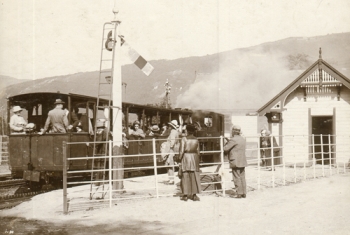
Recently Rated:
Stats
The Snowdon Mountain Railway – Racking up 117 years
Today, 5 April, is the 117th anniversary of Britain's only rack and pinion railway, the Snowdon Mountain Railway. It was opened purely to serve a tourist market, anxious to visit the highest point in England and Wales without having to go to the trouble of walking or taking a donkey ride to the summit. However, its opening day nearly became the last day of its operation.
The financial benefits to tourism were recognised by the Victorians who didn't miss any opportunity that was presented. With the coming of the railway to Llanberis in 1869, entrepreneurs saw an opportunity to build a railway to the summit of Snowdon, and make a lot of money in the process. Their efforts were frustrated for many years by the local landowner, George Assheton -Smith, who was part of the local dynasty who had extensive property interests, including Dinorwig quarry - the second largest slate quarry in Wales and in the world.Assheton -Smith's very 21 st century NIMBY ('Not In My Back Yard') view was that it would spoil the scenery. One could not imagine the Snowdon National Park giving permission today for such an undertaking!
Originally the railway was intended to leave from Rhyd Ddu on the west side of Snowdon but vested interests in the town of Llanberis realised that a lot of tourism income would be lost if it were to be built there and so the Railway was constructed from the town to the summit over an 18 month period.
TheSnowdon Mountain Railwayis asingle track linewiththree passing loops, narrow gauge (80cm / 2ft 7 in) rack and pinion railway which is 4 miles 1188 yd (7.512km) long, with an average gradient of 1 in 7.86. The steepest gradient is 1 in 5.5, and this occurs in a number of places. The railway rises a total of 3,140 feet, from 353 feet abovesea levelat Llanberis to 3,493 feet at Summit station. A smooth journey on the steep gradients is achieved by a double racked rail used with a rotating toothed pinion. The pinion is mounted underneath the locomotive and guarantees the locomotive does not lose grip on the mountain. The pinion is the only source of traction for the locomotive with the wheels supporting the weight of the engine. Some of the original rolling stock is still in use and, in contrast, three new carriages entered service in 2013.
On the opening day a disaster occurred on the Railway. Two trains climbed safely to the summit. On the first return trip down the mountain, the train with two carriages lost contact with the rack and ran out of control. The locomotive derailed and fell down the mountain. A passenger died from loss of blood after jumping from the carriage. The second downward train hit the carriages of the first, fortunately with no fatalities. An inquiry concluded that the accident had been triggered by post-constructionsettlement, compounded by excess speed due to the weight of the train. Additional safety precautions were put in place on reopening and the Railway has had a perfect safety record since.
Thecafe at the summitof Snowdon, described by the Prince of Wales as"thehighest slum in Wales" was demolished in 2006 to be replaced by a new 8.4m visitor centre three years later. It's slightly bizarre to find a cafe at the top of a mountain but when you've spent three hours walking through drizzle and mist, a hot drink is welcome.
For more information see Snowdon Mountain Railway website
Picture of Llanberis Station Snowdon Mountain Railway


